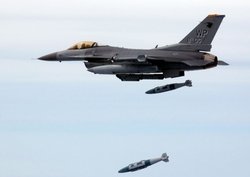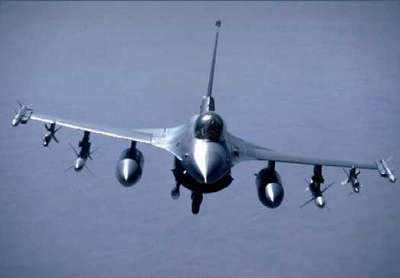Plenty Of Firsts
 The most recent deployment for the
107th Fighter Squadron was one of firsts, according to the unit's
commander.
The most recent deployment for the
107th Fighter Squadron was one of firsts, according to the unit's
commander.
Lt. Col. Glenn Schmidt said the Air National Guard unit became
the first F-16 Fighting Falcon squadron to be based in Iraq when it
established its base in Kirkuk in February. It also was the first
F-16 unit to use the Theater Airborne Reconnaissance System as well
as the first to use the Laser Infrared Targeting and Navigation
advanced targeting pod, he said.
TARS collects intelligence information from the battlefield's
second echelon and beyond, in adverse weather and all light
conditions. Litening gives tactical aircraft 24-hour
precision-strike capability against both land and sea-based
targets.
Weapons officer Lt. Col. Nate Dickman, pilots Lt. Col. Leonard
Isabelle and Maj. Brian Bracken and maintenance operations officer
Maj. David Spehar joined Colonel Schmidt at the Pentagon to discuss
the firsts and their mission in Iraq.
When the squadron -- based at Selfridge Air National Guard Base
(MI) -- got word it was being sent to Iraq, it was in the middle of
close-air support training. The squadron flies mostly CAS and
reconnaissance missions.
The combination of TARS and Litening allowed the group to be
flexible in its mission. Not only could the F-16 pilots help ground
troops out of sticky situations, they could do reconnaissance at
the same time, the officers said.
For example, if the unit was called upon to hit a target, the
TARS pod on one F-16 would take "before" and "after" images to
document exactly what kind and how much damage was done, Major
Bracken said. Images taken while flying CAS missions were also used
to update maps used for planning flight routes.
The images were processed within 30 minutes of landing. TARS
will have data-link capability for real-time imaging sometime next
year, Colonel Schmidt said.
The squadron did not have planned targets, Colonel Schmidt said.
Missions were driven by need and were mostly reactive in
nature.

"We quickly became (the ground troops') No. 1 go-to squadron for
support," he said. "They would ask for us by name."
When squadron officials were told it was being sent to Iraq, the
call for volunteers went out. Colonel Schmidt said there were more
volunteers than spots to be filled, and there was no need to
mobilize anyone. It deployed with 280 people and 10 aircraft.
"I didn't want to take additional people and put them in harm's
way," Colonel Schmidt said.
The group racked up around 3,000 flight hours in more than 800
sorties.
During the three-month deployment, about a year's worth of
flying was logged, Major Spehar said. This required heavy
maintenance while deployed in a war zone.
To keep the sand from doing more damage than the repairs were
doing good, the maintainers used hardened aircraft shelters, Major
Spehar said. Selfridge and an Air National Guard unit based in
Richmond (VA) -- the only other Air Guard unit to have the TARS
pods -- are constantly writing and rewriting guidelines for field
maintenance, he said.

Besides their close-air support and reconnaissance successes in
Iraq, officials said one fact made the squadron's largest
deployment since the Korean War especially successful: Everyone
came home.
(ANN salutes Samantha L. Quigley, American Forces Press
Service)
 ANN's Daily Aero-Linx (04.16.24)
ANN's Daily Aero-Linx (04.16.24) Aero-News: Quote of the Day (04.16.24)
Aero-News: Quote of the Day (04.16.24) Airborne 04.10.24: SnF24!, A50 Heritage Reveal, HeliCycle!, Montaer MC-01
Airborne 04.10.24: SnF24!, A50 Heritage Reveal, HeliCycle!, Montaer MC-01 Airborne 04.12.24: SnF24!, G100UL Is Here, Holy Micro, Plane Tags
Airborne 04.12.24: SnF24!, G100UL Is Here, Holy Micro, Plane Tags Airborne-Flight Training 04.17.24: Feds Need Controllers, Spirit Delay, Redbird
Airborne-Flight Training 04.17.24: Feds Need Controllers, Spirit Delay, Redbird





